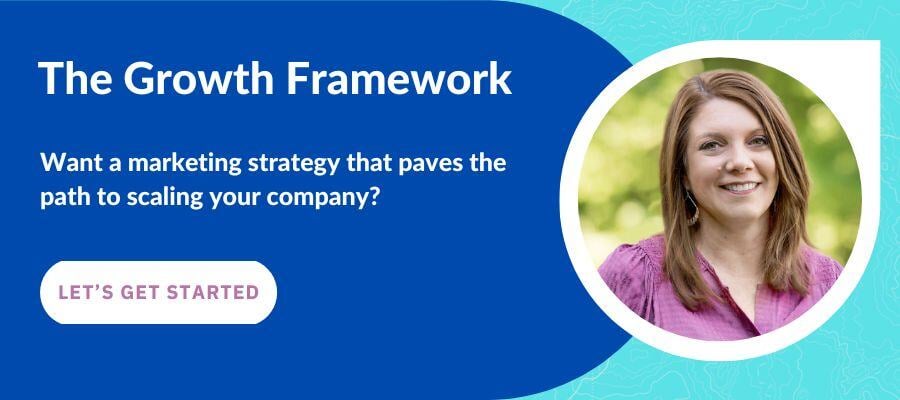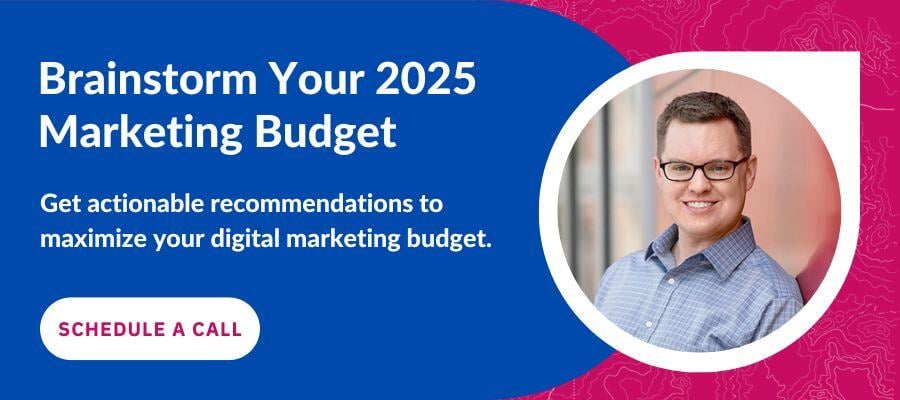If you’ve navigated the whirlwind of change in recent years, you’re clearly adaptable—but 2025 demands a fresh perspective. Everyone is talking about how AI will change the way we search online and the way we get our work done. It can leave you grappling with what might be a good investment in AI over the next year to make you more efficient and what you can incorporate into your marketing strategies.
As we step into 2025, it’s the perfect moment to pause, reassess your goals, and refine your approach to ensure your marketing efforts are driving growth and your investment into various technologies is worth it.
Here’s our updated list of recommendations to help you stay on track in 2025, drive revenue growth, and see a solid ROI on your marketing investments.
Top 6 Things To Include In Your 2025 Marketing Budget
- A marketing strategy that matches the buyer's journey
- A website that matches your marketing strategy
- AI tools that lead to increased sales
- Videos
- Content that supports sales
- A system for monitoring and collecting reviews
1: A Growth Marketing Strategy that Matches Your Buyers' Journeys
Whether you have direct competition or not, there are a lot of options for your potential customers to choose from. In fact, they could choose to do nothing at all. What makes them decide you're the right choice?
Before you spend any money on marketing campaigns, ads, website design, or anything else related to growing the company, you need a marketing strategy that complements the way your buyers are thinking and buying. We can guide you through this in a way you've not thought about before. Or, you can do this on your own, but either way, make sure you have these defined before you run any more marketing:
- Affirm your brand narrative: What problems do you solve for your customers and why do you do it? Don't assume they're the same as they've always been. This ensures you're staying in touch with the current issues your buyers are facing. When you're confident in the problems, you'll be able to talk about your solution in a way that meets them along the path toward a purchase.
- Define a solid competitive advantage: How are you different? While you may have better people than your competitors and offer better service, it's not enough to count as what sets you apart. Your competitive advantage should be something that every employee understands so they can support it and ensure that you're holding true to your core values.
- How to meet buyers on their journeys: How should you communicate with people who are at various stages of the decision-making process? This is going to help you define what to say and what to offer to those who are researching their problem and possible solutions.
If you're not sure how to extract all of these things from your team, including senior management, we can help.
2: A Website To Match Your Buyer's Journey
Once you've defined your buyer's journey, your website has to match it. Otherwise, what's the point of the work you did to define it? We're not talking about prettier pixels. Don't spend your money on that. You need a lead-generating machine that represents your brand and connects with your potential customers. It's the digital equivalent of inviting guests into your office or storefront.
Even if you just rebuilt your website, you can’t set it and forget it. It needs to match your buyer's journey, as defined in the growth framework. You also need to give your visitors (and Google) reasons to come back, which requires regular new and updated content.

For B2B companies, your website may be a prospect's ONLY interaction with your brand before they're interested in talking to the sales team.
- If your website is more than three years old, you need to seriously consider adding a redesign to your budget in 2025. Not only is the design probably in need of an update, but the technology it was built on may also need some refreshing.
- Use data to see what people like on your website and determine whether those pages are converting visitors into leads. For example, this page started as a simple blog that has become more popular. We pay a lot of attention to it because it’s obviously a hot topic for marketers and business owners. We knew that this page was an important area to focus on and build upon based on our data.
- Make sure you have a way to capture leads from your website so you can nurture them into customers. This sounds basic, but we see a lot of websites without this.
Quite literally, your website has never played a more important role in your business than it does right now.
3. AI Tools That Improve Productivity
Have you seen the explosion of AI tools for marketing and sales that are now available? It's mind-blowing, which makes it overwhelming to know what you need and what you can skip. Most marketers know they need to incorporate AI into their day-to-day work, but where should you invest the money?
Here are just a few ways you can use AI tools in daily marketing activities to increase productivity and, more importantly, more leads and sales.

Most of these marketing functions use generative AI. There are literally hundreds of tools that can do this. The best generative AI tools for your marketing team can depend on your current tech stack. You may be able to add AI within tools you have. HubSpot, Salesforce, SEMRush, Grammarly, and others offer tools for writing, social post creation, landing page content, and more. If you'd like to learn more about options that fit your needs, schedule a time to talk with our AI experts.

4: Videos: The Next Best Thing to Live Interaction

It's probably not a surprise that you need to have videos on your website. Videos that address the most common objectives are a great place to start. And they don't need to be highly produced videos. In fact, you can shoot many of them from your desk.
Here are three ideas for creating content:
- Answers to your most common sales questions. Get someone in front of the camera and let them answer the question! Now you're going to have a library of content that helps address the commonly asked questions that can help people before they reach out to your team. This increases their trust in your company and your products or services.
- Cost explanation videos. Openly and honestly talk about pricing and common objections to your price. This will be so helpful to potential customers when narrowing down their options.
- Sales videos. With some free (or nearly free) screen capture/webcam software, your salespeople can create videos that give that feeling of personal interaction with leads to help move them through the decision-making process. It's great for follow up.
5: Content (Written by Humans) to Support Your Sales Efforts
We've already talked about using AI to generate content. Just about everyone has done it, or is planning to. This has led to an explosion of content on the web. What will make your AI content stand apart from your competitors? Good question. A human touch can make content stand apart.
Not all content should be generated through AI. When humans create content, it allows for a more personal dive into the topic. (But by all means, let AI run through the content when you have a draft to see how it can be improved.) Using personal experiences demonstrates your knowledge. People like that. And Google likes that. Rather than just pumping out tons of blogs through AI, try this approach to content development in 2025.
- Create content that assists with selling. Pick your sales team's brain about the most common objections and questions they hear and your answer to them. You can be specific about how your organization overcomes the objection. This is a great starting point for written and video content (more on that in a minute). And, hopefully, you're creating resources your sales team can use.
- Content that improves existing customers' experiences. Talk to your customer service team about the questions they receive so you can create a knowledge base. As we learned already, customers are looking for a more self-service digital experience. Let them search for the answer they need in a knowledge base. Again, AI can be helpful in making the content easy to read.
Be sure this content has a place on the website and it's targeting key phrases that your potential customers are searching on the web. Not sure how to know what those phrases are? Ask us.
6: Reviews that Drive Conversions

Reviews have been around for a while now. Why? Because people trust them. It might feel a little awkward asking for them, but they are important enough that we hope you'll move outside your comfort zone.
You need a system for sending out review requests as well as monitoring the responses. Plus it's a good idea to show your reviews on your website. Google reviews will appear on Google -- but bringing that into your website reinforces to visitors that you're as good as you say you are!
We also recommend you run a net promoter survey to be sure you're aware of how likely customers are to recommend you to others. For those who are fans of your company, encourage them to give you reviews on Capterra, G2, Google, or whichever platforms are commonly used in your industry.
What to Budget for Marketing
Marketing is an investment. That investment should show returns. Make sure your investment is appropriate for the goals. If your aim is to double or triple your sales from the previous year, it's essential to align your budget accordingly. It's unrealistic to expect a $1 million increase in sales this year with just a $10,000 annual budget. That would be a 100x return on investment. While that would be awesome, it's not a realistic expectation.
Your budget should also be relative to the sales price. Typically, higher-priced items involve a more extended sales process, requiring additional nurturing and educational information compared to quicker (lower dollar) decisions. It's important to plan your budget accordingly to accommodate these needs.
Measuring Marketing Results
As the internal marketer, you have a pulse on management and what's important to them. Be sure you're addressing those key performance indicators (KPIs) from the start.
While you can't measure everything because some activities are brand-building rather than action-oriented, you need to have a way to show what's working in a way that matters to management. Here are some questions to ask before you set forth on developing your marketing strategy:
- What is your baseline for website visitors? How many non-customers come to your website per month right now, and what are they looking at?
- Are you converting leads on the website now? If yes, how many leads per month, and how many of those close? What are you aiming for?
- What is the expected timeline to reach goals? Be honest with management about your expectations. Not everything happens in a month or even a quarter -- especially if Google is involved.
Have any questions? Schedule a free consultation with our team.
Topics:
Marketing StrategyAugust 29, 2024





